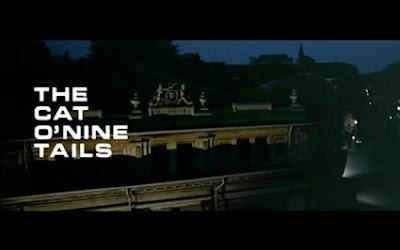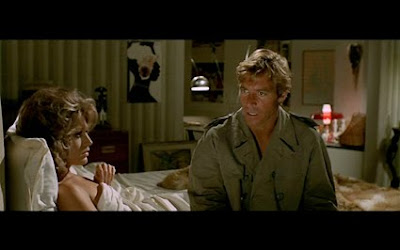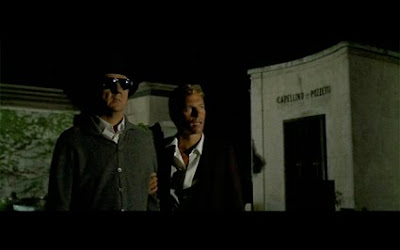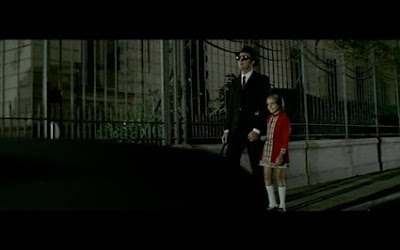

The Cat O’Nine Tails
Original Title: Il gatto a nove code
Directed by: Dario Argento
Italy/France/West Germany, 1971
Giallo, 112min
Distributed by: Anchor Bay
Following up his successful debut feature L’uccello dalla piume di cristallo (The Bird With The Crystal Plumage) 1970 cannot have been an easy task for the young Dario Argento. But follow it up he did, and took his exploration of the themes and styles that would become his signature moves within the Giallo genre further, but not necessary forward.
For some reason Il gatto a nove code (The Cat O’Nine Tails) 1971 often ends up in the middle or lower parts of most Argento fans lists. Sure with some twenty plus movies to his credit, it’s a tricky job arranging his films in any specific order. We all know which one’s we rate as his best movies, and we all know which ones we felt let down by… but with that said there’s several bloggers who are with a good measure of distance and time boldly revisited some of the lesser favourite movies and rediscovering them in a whole new light. I’ve decided to work my way through the catalogue methodically, step by step to see if I can reconnect and rediscover the progression of Dario Argento and see if the side steps really are as bad as I recalled them. In the meantime I recommend that you check out Ninja Dixon who has given three of the lower rated movies a new going over, and found some very interesting things in them.

Franco Arno [Karl Malden], a old blind gent living together with his niece Lori, [Cinzia De Carolis – later to be seen in Antonio Margheriti’s epic Apocalypse domain (Cannibal Apocalypse) 1980] overhears a conversation where the word "blackmail" is spoken whilst walking past the Terzi Institute. I don’t know why but I’ve been convinced that it’s his niece for years – but paying attention to the dialogue, Arno has no family and she no parents…. Arno later finds out from cocky reporter Carlo Giordani [James Franciscus] that a burglar had tried to steal something from the institute. Soon after this discussion, doctors and other people connected to the institute start getting knocked off one by one. In a great scene one of them is even pushed in front of a train. One of Giordani's colleagues happens to shoot a few shots with his camera during the accident at the train station, thus revealing the killers identity (only to him though) evoking a sequence catching the context of Antonioni's Blow Up. Staying true to Giallo convention, as soon as the killer is close to being revealed he strikes again. Arno and Giordani team up and start putting the pieces together in their attempt to solve the mystery. After concentrating their investigations on the people connected with the institute, they look to the Institute itself and finally discover that the answer would cause great scandal if ever revealed…

The Cat O’Nine Tails is a rather so-so Argento movie, it get’s the job done but not much more. It’s tricky to see why this one often is referred to as being the movie that secured Argento the epitaph; The Alfred Hitchcock of Italy, as his first feature overshadows this one in all possible ways. And where The Bird with the Crystal Plumage was very obvious in whom its leading man was I find that The Cat O’Nine Tails suffers terribly from the device of two amateur detectives. It fails miserably and never really becomes clear who is the main lead character – Malden or Franciscus. There’s an apparent lack of motivation to solve the case more than simple curiosity, which is one of the weakest reasons, as there’s no real value at stake like in many of Argento’s other Gialli.
It also lacks the flair and elegance of that successful debut feature the year before. I get the feeling that the movie is in some ways was rushed into production and therefore suffers for it. Characters are shallow – sure Franciscus and Malden give great performances, but what’s up with the leading lady Katherine Spaak? It’s no doubt that she’s one of the most boring and stiff leading ladies in any Argento movie so far. Once again, and in many Argento movies to follow, good old Fulvio Mingozzi makes an appearance as a police detective, and the gay character Dr. Braun played by Horst Frank is miserably under used. What is it with Dario Argento and gay characters… there seems to be one popping up ever here and there, but never really making any specific imprint.

Finally the reveal of the killer who has hardly been part of the narrative throughout the movie at the very end of the movie is a trick that several other Gialli have used before and after The Cat O’Nine Tails, but when it comes to Argento one expects more, as he’s the one who commonly is referred to as the leading name of the genre. There’s nothing leading with convention.

Within the Giallo genre there’s quite often scenes, clues and solutions that demand the audience to just accept what is going on without questioning. Stuff happens by chance, coincidentally characters will find something that will guide them forward in the quest, that vital clue that randomly lands in the grasp of the protagonist. I have a real problem with the fact that Arno – the blind man – is the one who on several occasions sees the clues, or rather “tells” Giordani where to look. It’s irritating that the blind man suggests that they look ”outside the cropped image” (read frame), as it is kind of strange that the blind guy should think of looking outside an image he cans see. There are several of these short, disclosed scenes with Arno, like the encounter in the cemetery, where he first fights off the killer but it all happens off screen whilst Giordanni is locked in the crypt. It’s not quite satisfying, and annoying to say the least – I watch Gialli because I want to be teased and part of the detective work, not to be kept in the dark.

But at the same time the ”cropped image” is kind of interesting as the off screen space is where the killers in Gialli dwell, and it’s almost as if Argento this early on in the film decides to mock the conventions he would help to sustain. By opening up the frame he’d expose the killer, and also takes the opportunity to homage that great Antonioni movie Blow Up 1966, just like Sergio Martino did the same year with La coda dello scorpione (Case of the Scorpions Tail) 1971.

It strikes me that there are no Gialli character gloved hands at all in the movie, instead these images are replaces by the close-up of the killers eyeball instead. It’s odd to revisit a movie after such a long time only to discover that the trait very personal to Dario Argento is missing completely from the film.

The comic character – just like those found in the spaghetti westerns and definitely in many Argento movies – is also apparent in The Cat O’Nine Tails, this time in the guise of the police detective who can’t stop talking about his wife’s cooking and never manages to catch anyone’s attention.

Then there’s that busting finale. The last act, from the vault’s under the cellar, the kidnapping of Lori and the final chase on the rooftops are some really fine moments, and almost make up for the pretty sloppy narrative up to that point. But don’t you feel that things move a bit too fast and then slam to a grinding halt? The killer is pushed down the elevator shaft and before he even hits the bottom the end credits start rolling… What happens to Giordani? Are Lori and Arno reunited? Etc etc. there’s a few questions that still are posed here and I don’t really find it satisfying that it’s ended where the killer is dead, as he was never the main driving force of the film, but Arno and Giordani where. You can’t have a scene where one of the two protagonists is knifed, beaten and left on the ground only to not give us a closure on that lead. It’s an irritating flaw that the movie never sorts out.

I’m pretty convinced that The Cat O’Nine Tails partially suffers from that bad rap as this is one of the films that Argento himself constantly states to like the least. It’s all too easy to follow him down that path and criticize the movie. Sure it does have some flaws, but at the same time does manage to entertain and pull me into the story even if I don’t really have a definitive character to root for.
Ennio Morricone’s score for The Cat O’Nine Tails is softer and gentler than the previous The Bird with Crystal Plumage, not to mention the frantic hard-hitting jazz score of 4 mosche di velluto grigio (Four Flies on Grey Velvet) 1971. Neither is Erico Menczer's cinematography anywhere near the splendid compositions and colour balance of Vittorio Storaro, but then again it does feature some interesting extreme close-ups of eyeballs, which is in suit with the exploratory imagery that soon would become Argento’s trademarks.
The Cat O’Nine Tails is the weakest of the three movies that make up the “animal” trilogy. It lacks several of the significant traits that are associated with Argento, and the characters are much more shallow than those before, and those to come. I can see why this one doesn't manage to make the same kind of imprint that other do. But it holds an interesting part in the lineage of Argento. It was the first movie that Dardano Sacchetti wrote, well the first he saw go into production at least, and the first collaboration between Argento and Sacchetti. It would take another sixteen years before the two worked on a movie together again, and that would be with Lamberto Bava’s Dèmoni (Demons) 1985. But as a team on an Argento movie the two would never work together again, perhaps because of the final result of The Cat O’Nine Tails. I can feel in some ways that The Cat O’Nine Tails may have grown some since I last saw it, but still is a weaker Dario Argento movie, and will forever be trapped between the impactful and impressive The Bird with Crystal Plumage and the ferocious for many years lost gem Four Flies on Grey Velvet 1971.
 Image:
Image:Widescreen 2.35:1
Audio:
Dolby Digital 2.0, English, French or Italian dialogue available, English or French subtitles optional
Extras:
Interviews with Argento, Ennio Morricone and writer Dardano Sacchetti. Theatrical Trailers, Tv Spots, Radio spots and Poster/Stills gallery (does anyone watch these?). There’s also an interesting radio interview with Malden and Franciscus too.







6 comments:
See, I probably feel about CAT O'NINE TAILS as you feel about Franco's COUNT DRACULA. I really like this film and see nothing wrong with it.
Franciscus and Malden make a top team, even though I'll agree that all characters are shallow. But that's giallo - a genre that by its virtue resists deep characterisation.
Also, that ending is one of the best and most haunting in all Argento films. It really is downbeat with the good-looking hero stabbed and perhaps dying, the kind-hearted blind man giving in to primal rage and becoming a killer himself. And god knows what happened to the little girl.
You've touched upon the abrupt ending subject here, and that's a whole big issue that hasn't been properly explored yet. It's a very common ending in Italian films: THE DESIGNATED VICTIM with Tomas Milian, BRONX WARRIORS, not to mention Fulci's CITY OF THE LIVING DEAD. I kind of like those endings, they really show you that it's only a movie which can be chopped whichever way the film-maker pleases. It de-constructs the narrative illusion which Hollywood has been nurturing.
And I absolutely love the photographer's murder in CAT, it's a total classic.
Argento says he hates the cinematography in CAT. Well, I say It's fucking gorgeous. Certainly pisses all over cinematography in TRAUMA, THE CARD PLAYER or THE THIRD MOTHER.
I will have to agree that Spaak is pretty awful. And another thing Dario never really excels at, apart from failing to explore gay characters, is the sex scenes - pretty lethargic in all his movies.
Alex. I agree. It is a pretty downbeat ending, but i feel that the lack of interest in characters doesn't really make me care that much if they live or die, and the mystery isn't really that engaging in my opinion. Then again in the really great storytelling pieces, the movies, books, stories end exactly where they have to according to the premise. and the premise here is WHO and WHY? So in away the movie does end exactly where it has too. I'm not saying that it's a bad film. I like Argento for his full body of work and specific titles mean more to me than others. If there's an Argento flick on the tube I'll watch it. Right now the Showtime channel that I have has been running a series of his films - Bird, Cat, Tenebrae, Phenomena and Stendhal, and if I'm not doing anything else I'll easily get stuck in front of those movies all over again. I've probably seen Suspira three times since christmas, but it doesn't really matter because I see new stuff in his work all the time. In Cat I had no recollection of the gay bar until Fred pointed it out last week. It was also just the other night that I realised that there where no gloved hands of the killer in here either...
I can sort of agree about the cinematography, but it's a huge step away from the great shots of Storaro's work on Bird. I found Frederic Fasano's work on Mothers pretty good, not to mention what he did with Do You Like... but I absolutely hated the floating Niccolodi spectre and wished that was never there. It's cheap and cheesy and brought a lot of cheapness to the film. And even though I wasn't too fond of CardPlayer debie's work is easily as good as it is on Cavaliere or the Noë films. But there's still a bunch of stuff to go before I get there.
About the sex scenes. It's been a long time discussion that Dario never quite felt comfortable directing these scenes, and I think that's why his movies took on a slightly more edgy sexuality when Asia started acting in his flicks, as he in some screwed up way felt more comfortable directing these scenes with his daughter instead. It was also said that sex scenes are a rarity in his early works... but we all know that's not quite true, although they certainly are uncomfortable. And then came 4 flies... ;)
I don't know if I agree that Gialli resist deep characterisations, but they certainly become easier to read and interpret with ONE single protagonist to walk by. I find that it all depends on the script, and that's why I feel Sacchetti, Gastaldi and a few others really make a difference. They draw up believable characters that many others don't and instead go for the shock and awe approach.
J.
Well, I do agree with most of your opinions, there are indeed good visuals in THE CARD PLAYER, but it doesn't have the grandeur of CAT. Speaking of DO YOU LIKE HITCHKOCK? - that is much underrated, that film did leave me genuinely thrilled. I really didn't expect anything from it and got lots of fun and then some.
The "Nicolodi Ghost" was pathetic,
(made The Grim Reaper from INFERNO look real in comparison!), as was the CGI witch-getting-impaled-on-a-stone-spire ending. I only saw MOTHER OF TEARS once, it was on a big screen projected from a DVD. Looked poor, the audience was getting hysterical towards the end of the film. So I didn't muster the guts to give it a second shot, but I will. I do watch Dario's films pretty often, but funnily enough SUSPIRIA is the one that I never really enjoy. But that's another story altogether:)..
Haven't yet seen FOUR FLIES, so looking forward to your review, let it be not too spoiler-ridden, huh:)
Ohhh.... Well I hope you'll pick up the Suspiria reference in Lyckantropen when you see it... :)
Ahaha, we'll see:)
Even though I say I don't get SUSPIRIA, I still watched it close to a dozen times, so there's a chance I might notice the reference...
You see, INFERNO has always been the daddy for me, as it was my very first Argento experience. And it's more of a culturally rich film than SUSPIRIA.
Yeah I LOVE Inferno. That was my first one too, and those underwater scenes in the opening sold me the whole package from there on. It's still one of the most amazing scenes in genre cinema ever...
Post a Comment